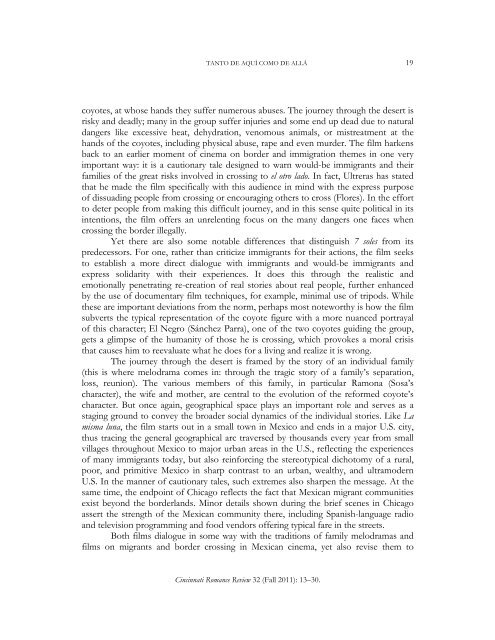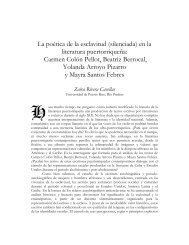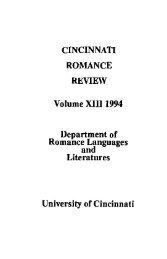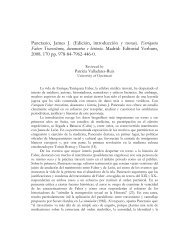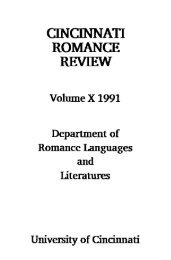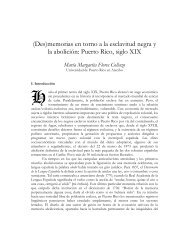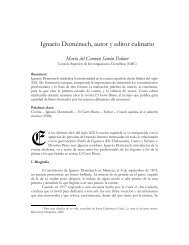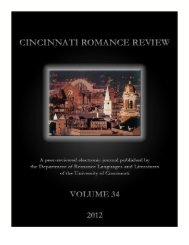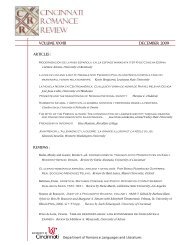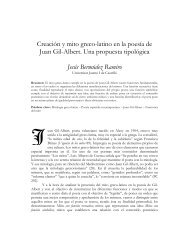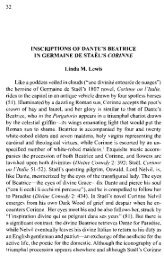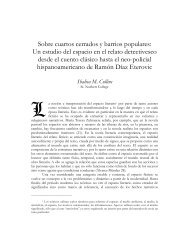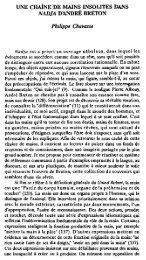Volume 32 (2011) - Cincinnati Romance Review
Volume 32 (2011) - Cincinnati Romance Review
Volume 32 (2011) - Cincinnati Romance Review
- No tags were found...
Create successful ePaper yourself
Turn your PDF publications into a flip-book with our unique Google optimized e-Paper software.
TANTO DE AQUÍ COMO DE ALLÁ 19coyotes, at whose hands they suffer numerous abuses. The journey through the desert isrisky and deadly; many in the group suffer injuries and some end up dead due to naturaldangers like excessive heat, dehydration, venomous animals, or mistreatment at thehands of the coyotes, including physical abuse, rape and even murder. The film harkensback to an earlier moment of cinema on border and immigration themes in one veryimportant way: it is a cautionary tale designed to warn would-be immigrants and theirfamilies of the great risks involved in crossing to el otro lado. In fact, Ultreras has statedthat he made the film specifically with this audience in mind with the express purposeof dissuading people from crossing or encouraging others to cross (Flores). In the effortto deter people from making this difficult journey, and in this sense quite political in itsintentions, the film offers an unrelenting focus on the many dangers one faces whencrossing the border illegally.Yet there are also some notable differences that distinguish 7 soles from itspredecessors. For one, rather than criticize immigrants for their actions, the film seeksto establish a more direct dialogue with immigrants and would-be immigrants andexpress solidarity with their experiences. It does this through the realistic andemotionally penetrating re-creation of real stories about real people, further enhancedby the use of documentary film techniques, for example, minimal use of tripods. Whilethese are important deviations from the norm, perhaps most noteworthy is how the filmsubverts the typical representation of the coyote figure with a more nuanced portrayalof this character; El Negro (Sánchez Parra), one of the two coyotes guiding the group,gets a glimpse of the humanity of those he is crossing, which provokes a moral crisisthat causes him to reevaluate what he does for a living and realize it is wrong.The journey through the desert is framed by the story of an individual family(this is where melodrama comes in: through the tragic story of a family’s separation,loss, reunion). The various members of this family, in particular Ramona (Sosa’scharacter), the wife and mother, are central to the evolution of the reformed coyote’scharacter. But once again, geographical space plays an important role and serves as astaging ground to convey the broader social dynamics of the individual stories. Like Lamisma luna, the film starts out in a small town in Mexico and ends in a major U.S. city,thus tracing the general geographical arc traversed by thousands every year from smallvillages throughout Mexico to major urban areas in the U.S., reflecting the experiencesof many immigrants today, but also reinforcing the stereotypical dichotomy of a rural,poor, and primitive Mexico in sharp contrast to an urban, wealthy, and ultramodernU.S. In the manner of cautionary tales, such extremes also sharpen the message. At thesame time, the endpoint of Chicago reflects the fact that Mexican migrant communitiesexist beyond the borderlands. Minor details shown during the brief scenes in Chicagoassert the strength of the Mexican community there, including Spanish-language radioand television programming and food vendors offering typical fare in the streets.Both films dialogue in some way with the traditions of family melodramas andfilms on migrants and border crossing in Mexican cinema, yet also revise them to<strong>Cincinnati</strong> <strong>Romance</strong> <strong>Review</strong> <strong>32</strong> (Fall <strong>2011</strong>): 13–30.


